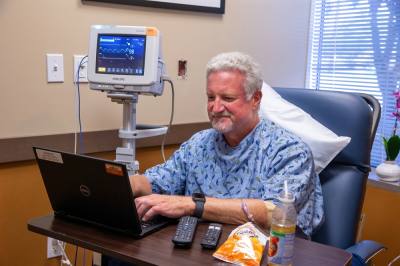Approximately 270,000 men are diagnosed with prostate cancer each year in the United States. Put another way, 1 in 8 men will fall ill to prostate cancer in their lifetime.
Though most will be successfully treated with established therapies like surgery, radiotherapy and chemotherapy, there are a significant number of men whose cancer will progress despite these treatments. These men now have a new treatment option—targeted radiopharmaceutical therapy.
Physicians and staff at ARA Diagnostic Imaging, a health care group experienced in the use of radiopharmaceuticals to diagnose and treat disease since the 1960s, have begun offering a new targeted radiopharmaceutical treatment for prostate cancer patients.
Pluvicto, approved by the U.S. Food and Drug Administration in April, offers a treatment for prostate cancer in men whose disease has progressed despite having received traditional therapies.
Molecular radiologist Dr. Jack Leahy, who has worked with ARA for 22 years, is confident Pluvicto will positively change the course of many mens’ battles with the disease.
“This radiopharmaceutical has a strong attraction to prostate cancer cells, but not other types of cells, like healthy prostate cells,” Leahy said. “After being given by intravenous injection, it circulates through the body locating and attaching itself to prostate cancer cells wherever they are—even pockets of cancer that are not visible to the naked eye or conventional imaging. It then attacks those cells with minute amounts of radiation, leaving the surrounding tissues virtually untouched.”
Pluvicto is administered over six sessions, each of which last a few hours, with a period of six weeks in between each session.
ARA is providing the Pluvicto treatment to patients at its ARA Theranostics Center, which is located in the Midtown office. Because this is a new treatment, it is not universally covered at the time of publication, but coverage status is changing rapidly.
Some patients with Medicare and some private insurance groups may be eligible for coverage now, and full coverage for all patients is expected later this year. The ARA team will work with each patient individually to determine their options.
“We’re excited about this new treatment. The clinical studies show it is going to be really helpful for a lot of men,” Leahy said. “When other therapies have stopped working, most men are still able to respond to Pluvicto, and it is for that reason it is being offered today. But because early results have been so encouraging, researchers are now saying, ‘What if we tried it earlier? Could it actually have a better effect?’”
In addition to its current use as an option for men whose cancer is progressing on traditional therapy, clinical trials have begun to evaluate Pluvicto as an earlier treatment.
Also, Pluvicto is just one of a new class of radiopharmaceuticals targeted at specific cancers—these other agents are currently in clinical trials. According to Leahy, the future is bright for targeted radiopharmaceutical therapy.
Experts at ARA work with patients’ urologists and oncologists to come up with the best treatment plan for the individual. Those who have been diagnosed with prostate cancer and want to find out more can visit https://www.ausrad.com/exams-services/theranostics/pluvicto/.
The above story was produced by Community Impact's Storytelling team with information solely provided by the local business as part of their "sponsored content" purchase through our advertising team. Our integrity promise to our readers is to clearly identify all CI Storytelling posts so they are separate from the content decided upon, researched and written by our journalism department.
Select your community
Support Us
News
- Austin Metro
-
Houston Metro
- Houston Metro Home
- Bay Area
- Bellaire | Meyerland | West University
- Conroe | Montgomery
- Cy-Fair | Jersey Village
- Cypress
- Heights | River Oaks | Montrose
- Katy | Fulshear
- Lake Houston | Humble | Kingwood
- New Caney | Porter
- Pearland | Friendswood | Manvel
- Spring | Klein
- Sugar Land | Missouri City
- The Woodlands
- Tomball | Magnolia
- Dallas | Fort Worth Metro
- San Antonio Metro







